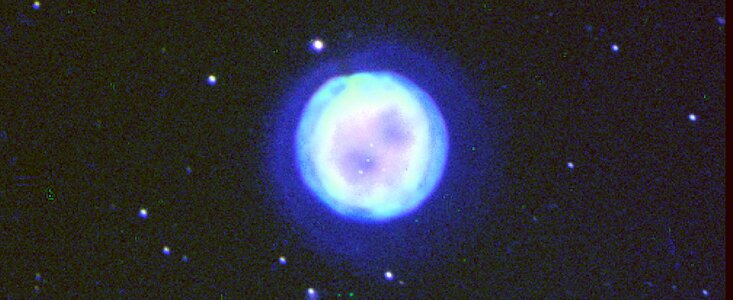Raptor Evolution on a Cosmic Scale: Why the Owl Nebula Looks Like an Owl
9 Julio 2003
Astronomers have assembled the first effective model for both the shape and evolutionary history of the Owl Nebula, the well-known planetary nebula in the constellation Ursa Major.
Named for its ghostly similarity to the face of the carnivorous bird of prey, the Owl Nebula (NGC 3587) has a complex structure consisting of three concentric shells. The aptly named nebula boasts a faint outer halo, a circular middle shell, and a roughly elliptical inner shell. The inner shell houses a bipolar cavity that forms the owl’s “eyes,” and two areas of enhanced brightness are seen as the owl’s “forehead” and “beak.”
In an article published in the June 2003 Astronomical Journal, researchers from the University of Illinois at Urbana-Champaign, the Instituto de Astrofísica de Canarias in Spain, and Williams College in Williamstown, MA, present the first cohesive model for the appearance and evolution of the Owl Nebula.
Using observations made with the William Herschel Telescope in La Palma, Spain, and the 0.6-meter Burrell Schmidt telescope at Kitt Peak National Observatory, the researchers concluded that the halo of the Owl was formed when the parent star first underwent significant mass loss after the cessation of fusion in its core. The resulting instabilities then produced a stellar wind, driven by a combination of stellar pulsations and radiation pressure.
Evolution of the Owl’s parent star caused the stellar wind to intensify to a “superwind,” driving even more gas and dust outward to form the middle shell. A subsequent faster stellar wind compressed the superwind to form the inner shell and bipolar cavity, but that wind has since ceased. The cavity is currently being back-filled with nebular material in the absence of the fast stellar wind, much as air flows back out of a balloon if you stop blowing into it.
“Different evolutionary models can produce the same structure for the nebula, but until now none has been able to also account for its motion,” says Martin A. Guerrero of the University of Illinois, the lead author of the recent study. “There are many investigations of physical structures of planetary nebulae, but most studies only look at one piece of data and tend to ignore the bigger picture.”
Other planetary nebulae show triple-shell structure similar to the Owl Nebula and it is likely that they followed this same evolutionary path, according to co-author Karen Kwitter of Williams College. “These nebulae form an illuminating sample to study, and the Owl Nebula is the nearest one, only about 2,000 light-years from Earth.”
Despite the name, planetary nebulae are not related to planets. Sir William Herschel gave these fascinating objects their misleading name in 1782 because, through his telescope, they resembled the appearance of Uranus and Neptune. In reality, planetary nebulae are shells of gas and dust ejected from aging stars. When the mass loss is finished, the hot core of the star is exposed, causing the ejected gas to glow.
Notas
The Burrell Schmidt telescope is part of the Warner and Swasey Observatory of Case Western Reserve University, Cleveland, OH. The telescope is located at Kitt Peak National Observatory near Tucson, AZ, which is part of the National Optical Astronomy Observatory (NOAO). NOAO is operated by the Association of Universities for Research in Astronomy (AURA) Inc., under a cooperative agreement with the National Science Foundation.
Enlaces
- A newly processed image of the Owl Nebula from this study is available above.
Contactos
Douglas Isbell
Public Information Officer National Optical Astronomy Observatory
Tel: 520/318-8214
Correo electrónico: disbell@noao.edu
James Kloeppel
University of Illinois News Service
Tel: 217/ 244-1073
Correo electrónico: kloeppel@uiuc.edu
About the Release
| Release No.: | noao0310 |
| Legacy ID: | NOAO 03-10 |
| Nombre: | Owl Nebula |
| Facility: | Burrell Schmidt Telescope |
| Science data: | 2003AJ....125.3213G |



